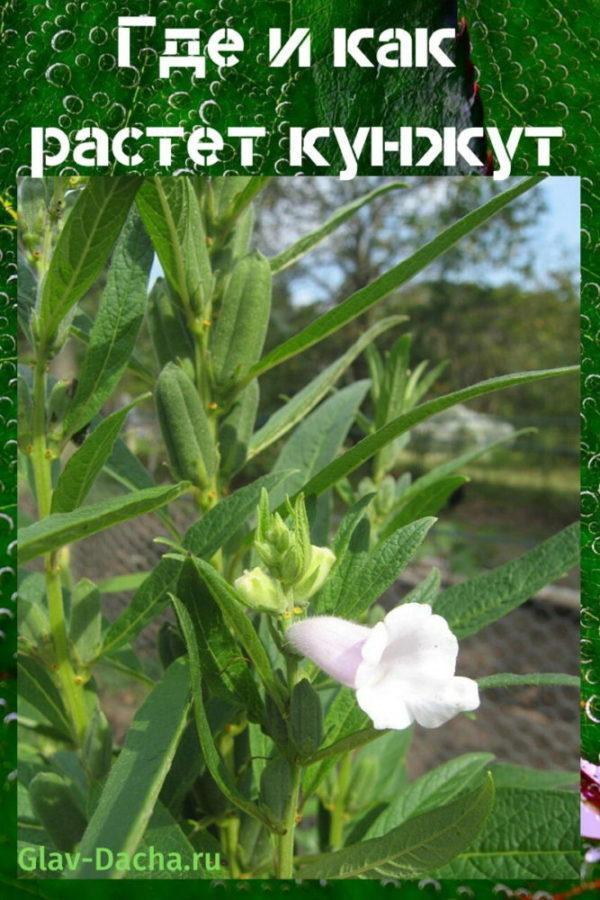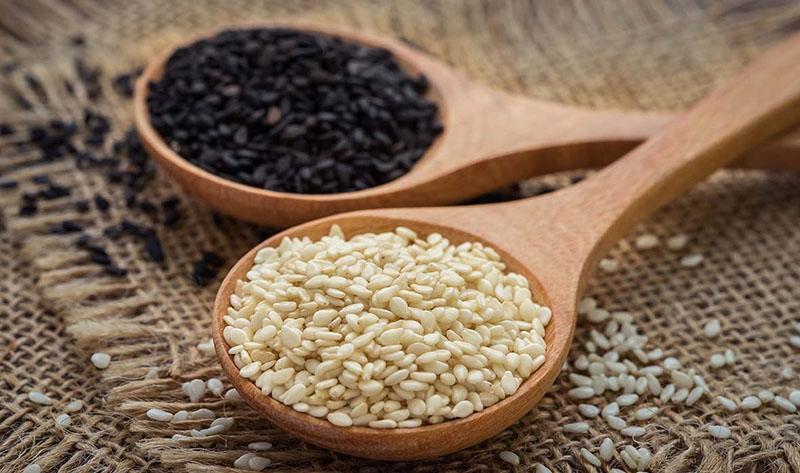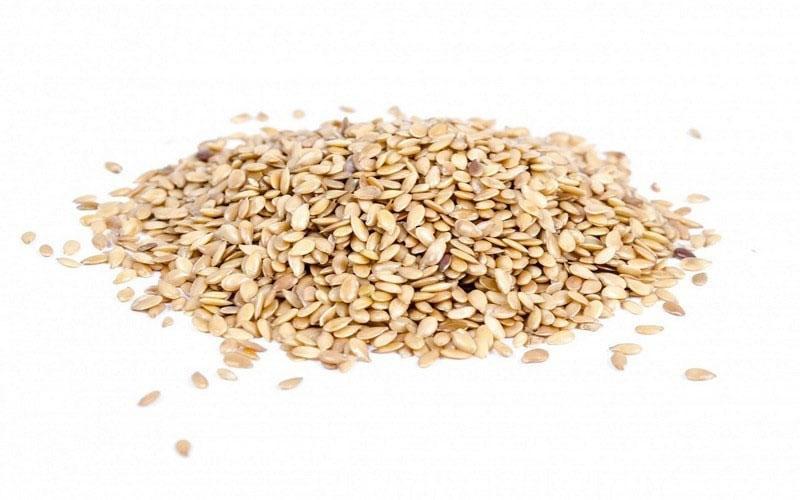Where and how does sesame grow
 What is and how sesame grows, it is important to know the gardener for successful plant growth on the site. Sesame, also known as sesame, is an annual herbaceous heat-loving plant. The average height of the bush is 1-1.5 meters, and under favorable growing conditions it can reach 3 meters. The plant has a tap root system with many lateral roots. The main root sinks into the soil to a depth of 1 meter, so that sesame can be cultivated in arid conditions and get a good harvest.
What is and how sesame grows, it is important to know the gardener for successful plant growth on the site. Sesame, also known as sesame, is an annual herbaceous heat-loving plant. The average height of the bush is 1-1.5 meters, and under favorable growing conditions it can reach 3 meters. The plant has a tap root system with many lateral roots. The main root sinks into the soil to a depth of 1 meter, so that sesame can be cultivated in arid conditions and get a good harvest.
On the erect stem of the plant are smooth or slightly pubescent oblong leaves. Sesame has large tubular white, pink, or purple flowers located in the leaf axils. The duration of their flowering is only a day, and during this time the flowers have time to self-pollinate. When the flower withers, a cylindrical box 3-5 cm in size is formed in its place, in which there are tiny seeds. In one box, about 80 seeds are formed, the weight of which is about 2 grams.
Types of sesame seeds and the benefits of its seeds

Despite the fact that these plants are of the same species, they have a number of differences:
- White sesame seeds have a delicate nutty flavor and delicate aroma. This seasoning has long been used in cooking. White sesame seeds complement and reveal the flavor of the main dish, as well as improve its appearance. Bakery products and other pastries decorated with white sesame seeds turn out to be very beautiful and aromatic.
- Black sesame has a more intense flavor and aroma. It is from this type that oil is made, which is very popular in Asian cuisine. Black sesame has a slightly bitter aftertaste, so it is more often used for cooking rice, meat or vegetables. In addition, black sesame has found application in medicine and cosmetology, due to its positive effects on the human body.

In addition to the original and piquant taste, sesame seeds, regardless of type and color, have a lot of useful properties:
- Sesame has powerful antioxidant properties due to its high content of the valuable substance sesamin. It lowers blood cholesterol levels, prevents premature aging of cells and tissues, improves the condition of nails and hair, and is also a good prevention of various diseases.
- Sesame is highly prized due to the high content of high quality vegetable protein in its grains. It is this property that makes sesame an important ingredient in many dishes that are included in the vegetarian menu.
- Sesame seeds, especially unpeeled seeds, contain a large amount of calcium. Therefore, it is recommended to systematically eat them, especially for children and the elderly to strengthen bone tissue and joints. Sesame seeds can also be a source of calcium for people with lactose intolerance.
- The rich composition of vitamins and minerals contained in sesame helps to normalize metabolic processes in the body and maintain vitality.
Regular consumption of sesame seeds helps to strengthen the immune system and the muscular system, has a beneficial effect on vision and vascular health.
Where and how does sesame grow
 Sesame is a thermophilic plant, so hot tropical and subtropical climate is ideal for its cultivation. Since ancient times, sesame has been cultivated as a cultivated plant in Africa and India, where it is still found in the wild. Later, the culture spread to other territories with suitable growing conditions - the countries of Southeast Asia and the Arabian Peninsula. Currently, the largest areas under sesame are occupied in North and East Africa, India, and America.
Sesame is a thermophilic plant, so hot tropical and subtropical climate is ideal for its cultivation. Since ancient times, sesame has been cultivated as a cultivated plant in Africa and India, where it is still found in the wild. Later, the culture spread to other territories with suitable growing conditions - the countries of Southeast Asia and the Arabian Peninsula. Currently, the largest areas under sesame are occupied in North and East Africa, India, and America.
The main conditions for growing sesame seeds are warmth, and humidity is of secondary importance. This property is due to the special structure of the root system, which is capable of deepening up to a meter into the soil, which makes it possible to cultivate sesame seeds in arid regions.
Interest in sesame seeds has greatly increased in recent years thanks to the popularization of the principles of healthy eating. Therefore, many agricultural producers, as well as ordinary gardeners living in countries with a warm climate, are interested in the question of how sesame grows and whether it is possible to master the cultivation of this valuable plant. The southern regions of Russia and Ukraine, Transnistria, as well as the countries of the Caucasus and Central Asia are quite suitable not only for amateur cultivation, but also for the industrial production of sesame seeds.
 With proper care and favorable conditions, sesame seedlings appear in about a week. Until the seedlings appear, it is necessary to ensure that a crust does not form on the surface of the soil, otherwise the seedlings will not be able to break through it. For this, the land must be constantly in a loose state.
With proper care and favorable conditions, sesame seedlings appear in about a week. Until the seedlings appear, it is necessary to ensure that a crust does not form on the surface of the soil, otherwise the seedlings will not be able to break through it. For this, the land must be constantly in a loose state.
 After the seedlings appear, they must be thinned out, leaving gaps between the plants 8-10 cm long. In an arid climate and rare watering, it is simply necessary to leave a sufficient distance between seedlings in a row, as well as between rows. This allows the plants to receive a larger area of nutrition, and also makes it easier to care for them.
After the seedlings appear, they must be thinned out, leaving gaps between the plants 8-10 cm long. In an arid climate and rare watering, it is simply necessary to leave a sufficient distance between seedlings in a row, as well as between rows. This allows the plants to receive a larger area of nutrition, and also makes it easier to care for them.
In addition to industrial cultivation, the plant is widespread in landscape design... Its original tubular bell flowers will adorn any flower garden, despite the short flowering period.
Growing rules

Growing sesame seeds requires certain conditions:
- Light mode. The plant needs a long day of light, which should be at least 12 hours.
- Temperature conditions. Planting sesame seeds should be done when the soil warms up to + 18 ° С, and the air temperature does not drop below + 25 ° С. Even a slight drop in temperature can lead to partial crop loss. Also, low temperatures, especially in combination with high humidity, contribute to the spread of fungal diseases, which can destroy not only the crop, but also the plants themselves.
- Humidity. Sesame is a drought-resistant plant and the main requirement to be considered is sowing seeds in moist soil. In the early stages of growth, the plant also needs moisture, but, as a rule, spring rainfall is sufficient for it.
In the absence of rain during the sowing period, it is necessary to make a one-time water-charging irrigation.
Soil requirement
 Sesame grows best on light to medium well-drained soils with a close location of groundwater. The acidity of the soil should be neutral, although on slightly acidic soils it also shows a good result. What can not be said about saline and waterlogged soils - in such places sesame will not grow at all.You can also grow sesame seeds on black soil or other soils, as long as they are well drained.
Sesame grows best on light to medium well-drained soils with a close location of groundwater. The acidity of the soil should be neutral, although on slightly acidic soils it also shows a good result. What can not be said about saline and waterlogged soils - in such places sesame will not grow at all.You can also grow sesame seeds on black soil or other soils, as long as they are well drained.
Sesame is very picky about its predecessors, the best of which will be cereals, melons and legumes. But after sunflower it is better not to plant sesame seeds. Also, experts do not recommend growing for two years in a row in one place. Moreover, it is advisable to return the culture to the same place not earlier than after 6 years. This is done in order to avoid the risk of disease and pests.
Sowing dates
 Sesame seeds are sown into the soil when the sowing layer warms up to a temperature of 16-18 ° C.
Sesame seeds are sown into the soil when the sowing layer warms up to a temperature of 16-18 ° C.
Until the earth warms up to the optimal temperature, sowing is not worth it because of the high probability of being infected with fusarium - the most dangerous disease of sesame seeds.
Before sowing seeds, the soil must be fertilized. For 1 sq. m. soil, the following amount of mineral fertilizers should be applied:
- 20 g of potassium chloride;
- 30 g of ammonium nitrate;
- 100 g superphosphate.
Sowing should only be done in wet soil If there has been no precipitation for a long time, the soil should be moistened before planting seeds.
The requirements for sesame seed are the same as for other crops - the seeds must be of high quality, full-bodied, without visible signs of disease or decay. Before sowing, they should be soaked for a day in plain water, and then, if desired, treated with a fungicide to protect against diseases.
Since the sesame seeds are very small, the planted area must be well leveled. Seeds are sown to a depth of 2-3 cm with row spacing of 50-70 cm. After sowing, it is imperative to roll the soil.
Care rules
 During the thinning of seedlings, it is necessary to leave the largest and most powerful plants. The main care for sesame seeds is the systematic loosening of row spacings and removing weeds. After rains, especially showers, it is necessary to destroy the crust that forms on the surface of the soil. This agricultural practice allows you to maximally preserve moisture that has gotten with precipitation and frees you from the need for additional irrigation.
During the thinning of seedlings, it is necessary to leave the largest and most powerful plants. The main care for sesame seeds is the systematic loosening of row spacings and removing weeds. After rains, especially showers, it is necessary to destroy the crust that forms on the surface of the soil. This agricultural practice allows you to maximally preserve moisture that has gotten with precipitation and frees you from the need for additional irrigation.
When the temperature drops to 2-3 ° C, sesame plants die, therefore, if there is a threat of a severe cold snap, the seedlings must be protected with a covering material.
This is the main problem faced by farmers in a temperate climate. However, breeders are actively working to develop new genotypes that are resistant to low temperatures and diseases.
 The growing season, depending on the variety, ranges from 90 to 130 days. As you watch the sesame seeds grow, it is important not to miss the moment the harvest begins. Yellowing and dropping of the leaves signals that the crop is ripe. Small areas are cleaned by hand.
The growing season, depending on the variety, ranges from 90 to 130 days. As you watch the sesame seeds grow, it is important not to miss the moment the harvest begins. Yellowing and dropping of the leaves signals that the crop is ripe. Small areas are cleaned by hand.
One of the biological features of sesame plants is the uneven ripening of fruits. At a time when the lower capsules are already fully ripe, the upper ones are still greenish, the seeds in them hold tightly and are poorly threshed. When the fruits are well ripe, they open very easily. The slightest touch or even a breath of wind is enough for the pod to open, and the seeds can spill directly onto the ground.
To minimize crop losses, collect the boxes slightly unripe, and then dry them in the sun until they are completely dry.
How sesame is used
 Ancient civilizations knew about the healing properties of sesame seeds. To this day, this valuable product remains very popular with almost all peoples.
Ancient civilizations knew about the healing properties of sesame seeds. To this day, this valuable product remains very popular with almost all peoples.
Since olden times, people have learned to use the beneficial properties of sesame in different areas of life, such as:
- cooking;
- the medicine;
- cosmetology;
- Agriculture;
- landscape design.
The greatest distribution of sesame is due to its use in cooking, especially in dietary nutrition.Most Asian dishes include sesame seeds in one form or another, whether whole grains crushed into a paste or powder mixed with salt.
In the national cuisines of the Middle East, a special place is occupied by tahini paste, which is made from pounded sesame seeds. In many Middle Eastern countries, such pasta is an indispensable element of the daily diet. On its basis, sauces and thick gravies are prepared. Pasta is added to falafel and meat dishes, mixed with fruit syrups and spread on bread. Many oriental sweets are prepared on the basis of tahini, for example, halva.
Application in medicine and cosmetology
 The healing properties of sesame were discovered in antiquity, and people learned to use them to fight disease, as well as to maintain health and longevity.
The healing properties of sesame were discovered in antiquity, and people learned to use them to fight disease, as well as to maintain health and longevity.
Many recipes for traditional medicine over the centuries have helped to cope with such ailments:
- colds and coughs;
- sore throats and throat diseases;
- digestive disorders;
- exacerbation of asthmatic and pulmonary diseases;
- high blood pressure;
- atherosclerosis;
- depressive conditions.
Official medicine also recognizes the positive effects of sesame seeds on the human body. On the basis of sesame oil, fat-soluble preparations for injections, as well as wound healing plasters and ointments are produced.
 For the production of various cosmetics, sesame oil is used, which has nourishing and regenerating properties. Sesame-based cosmetic preparations soften and eliminate skin flaking. They also help fight the early signs of aging. Masks for face and hair are made from sesame seed oil, and it is also used in massage procedures. Due to its ability to absorb ultraviolet rays, sesame oil is used in the manufacture of sunscreen cosmetics.
For the production of various cosmetics, sesame oil is used, which has nourishing and regenerating properties. Sesame-based cosmetic preparations soften and eliminate skin flaking. They also help fight the early signs of aging. Masks for face and hair are made from sesame seed oil, and it is also used in massage procedures. Due to its ability to absorb ultraviolet rays, sesame oil is used in the manufacture of sunscreen cosmetics.